Where to Buy Native Plant Seeds
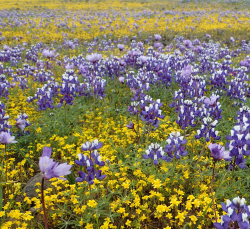 Late fall and winter are the best times to sow native plant seeds. Online sources offer the widest selection of native plant seeds, but it is possible to find them in local stores. It often takes a little searching to find them -- here are some tips here to help you locate them. If you know of seed sources in the Bay Area that are not included on this page, please send updates to This email address is being protected from spambots. You need JavaScript enabled to view it..
Late fall and winter are the best times to sow native plant seeds. Online sources offer the widest selection of native plant seeds, but it is possible to find them in local stores. It often takes a little searching to find them -- here are some tips here to help you locate them. If you know of seed sources in the Bay Area that are not included on this page, please send updates to This email address is being protected from spambots. You need JavaScript enabled to view it..
Bay Area Stores where native seeds have been spotted
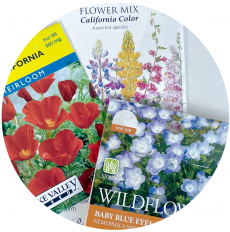 Many nurseries and even big box hardware stores carry a limited number of native plant seeds and seed mixes, but it can be challenging trying to find packets of seed mixes with only natives as many mixes that include "California" in the name include non-native seeds. It's important to carefully read the list of included flowers before buying. We've identified two native seed mixes that have been spotted in Bay Area stores:
Many nurseries and even big box hardware stores carry a limited number of native plant seeds and seed mixes, but it can be challenging trying to find packets of seed mixes with only natives as many mixes that include "California" in the name include non-native seeds. It's important to carefully read the list of included flowers before buying. We've identified two native seed mixes that have been spotted in Bay Area stores:
Both of these companies also offer seed mixes with similar names that contain non-native plant seeds, so be sure to check carefully before purchasing.
Stores where these and other native seeds and native seed mixes have been found:
- Almaden Valley Nursery,15800 Almaden Expy, San Jose - Carries Botanical Interests seeds. Look for "California Color Flower Mix Seeds". There are a number of other mixes that include the word "California" in the name, but contain non-native species.
- CNL Native Plant Nursery, 254 Shoreline Hwy, Mill Valley - Variety of native seeds, many of them locally grown and packaged.
- Home Depot - Carries Stover seeds. Look for "California Native Wildflower Mixture". Available in 1.5oz and 10gm. There are several similarly named Stover mixes that contain non-natives, so be careful. You can also order directly from Stover.
- Summerwinds - Carries Botanical Interests seeds. Look for "California Color Flower Mix Seeds". There are a number of other mixes that include the word "California" in the name, but contain non-native species.
- Watershed Nursery, 601 A Canal Blvd., Richmond - Carries a nice selection of locally grown native seed mixes.
- Yerba Buena Nursery, 12511 San Mateo Rd. (Hwy 92), Half Moon Bay. Good selection of seeds.
Availability changes frequently, so call ahead or ask at the information desk if you have trouble locating seeds.
California Poppies
 The most commonly available native plant seeds are California poppies. Since there are many non-native poppies, make sure the botanical name is "Eschscholzia california" when choosing poppy seeds. In addition to the well known orange California poppies, California poppy seeds are available for a rainbow of other colors. Some commonly available ones include:
The most commonly available native plant seeds are California poppies. Since there are many non-native poppies, make sure the botanical name is "Eschscholzia california" when choosing poppy seeds. In addition to the well known orange California poppies, California poppy seeds are available for a rainbow of other colors. Some commonly available ones include:
- Mission Bells - a double/semi-double variety with a rainbow of colors - white, orange, red, yellow and rose.
- Mikado - scarlet-orange
- Sundew - lemon-yellow
Online vendors with a wide selection of California poppies:
Online Seed Stores
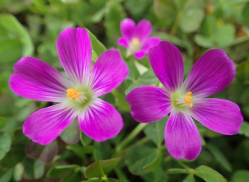
CANativeSeeds - Online seed store based in Castro Valley.
Larner Seeds; PO Box 407 or 235 Grove Road; Bolinas 94971; (415) 868-9407; Mail order seeds and California native wildflowers, perennials, grasses, shrubs, and trees. Retail plants at the nursery from October through July.
Natureseed.com: Natureseed.com took over distribution for Pacific Coast Seed and Hedgerow Farms. They also carry seeds from a variety of other sources, so it's important to read the species list carefully when you are buying mixes as many of them include non-native seeds.
San Diego Chapter, California Native Plant Society seed store; San Diego, CA, Contact Form; Sells California native seeds primarily from Southern California in small quantities for home and demonstration gardens
Seedhunt; PO Box 96, Freedom 95019; Mail order annual and perennial seed with hard to find selections and about one-third native
The Theodore Payne Foundation for Wildflowers and Native Plants Inc.;10459 Tuxford Street, Sun Valley 91352, (818) 768-1802; Online ordering available for seeds. Many useful plant resources on the site
S&S Seeds; P.O. Box 1275, Carpinteria, CA 93014; (805) 684-0436; Wholesale seeds, with $150 minimum order.
Stover: Seeds are often also available at Home Depot. In addition to "California Native Wildflower Mixture" they often have Narrow-Leaved Milkweed (Asclepias fascicularis), Baby Blue Eyes (Nemophila menziesii), Blue Flax (Linum lewisii), Desert Bluebells / California Bluebells (Phacelia campanularia).
Basics of Gardening for Habitat
Understanding the Basics of Gardening for Habitat
What Brings Bees, Butterflies, Moths and Birds to our Garden
What is Gardening for Habitat? Learn why it's important: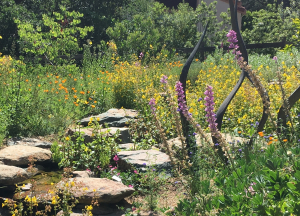
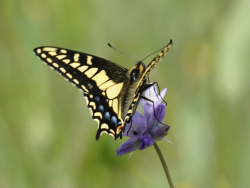 Ready to get started? Here are some simple steps to transform your garden into a welcoming place for birds, butterflies, bees and other wildlife:
Ready to get started? Here are some simple steps to transform your garden into a welcoming place for birds, butterflies, bees and other wildlife:
- How can you restore nature in your garden? Dennis Mudd shares his insights
- Need more information about pollinator plants and bees? Juanita Salisbury answers your questions in this talk.
- Seeking butterfly resources? The Xerces Society is a great resource as well as the Bay Area Wildlife resource website.
- Looking for more native seeds? Check out the great selection at Larner's Seeds. Various mixes are also available from Pacific Coast Seeds.
Getting Started with Native Plants in your Garden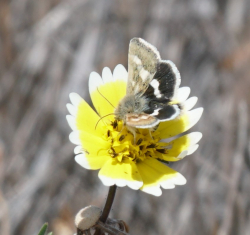
- Need help getting started with a native plant garden? Tips are available in this video
- When should you plant, water, prune, or leave things alone? Helen Popper shares a month-by-month guide for California gardeners.
- What planting methods and soil will ensure success? Haven Kiers from UC Davis shares some research.
- Want to find more California Native plants specific to your area, and the butterflies that use them as host plants? Then check out the wonderful CNPS Calscape website, which includes descriptions and planting information about every California native plant and links to native plant nurseries all over the state. For a user guide to using this amazing resource, watch this talk.
- Check out the great resources on our website and the numerous talks on native plant gardening and native plant science on our YouTube channel.
- Need Plants? Find nurseries, seed stores and plant sales using our list of local retailers.
- Looking for a list of great books for gardening with native plants and for wildlife? Go to our resource page for books.
Activities for Native Plant Gardeners
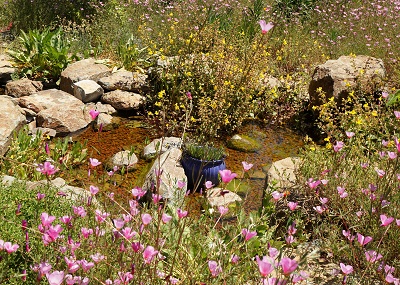 Want to do more?
Want to do more?
- Join us on a chapter field trip. See what's coming up here or on our Meetup page.
- Discover flora and fauna in your region and across the globe, and even post your own observations on the iNaturalist app.
- Attend the chapter's annual Growing Natives Garden tour.
- Want to see most of California’s native habitats in one location? Check out the Regional Botanic Garden in Tilden Park.
- Visit other public gardens with native plants. Here's is a list to get you started.
- The CNPS state website also has excellent resources and information to get you started with native plant science or gardening, like Bloom! California.
Native Plantings in Jeffrey Fontana Park
 A beautiful selection of mature and new native plant gardens can be found in Jeffry Fontana Park in San Jose. Wandering through the park, you will find plants from both northern and southern California in a variety of settings.
A beautiful selection of mature and new native plant gardens can be found in Jeffry Fontana Park in San Jose. Wandering through the park, you will find plants from both northern and southern California in a variety of settings.
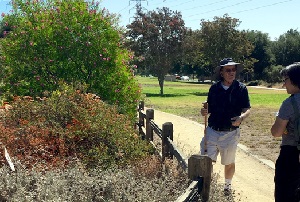 This is the perfect place to view plants that grow well in San Jose and find ideas for your own gardens.
This is the perfect place to view plants that grow well in San Jose and find ideas for your own gardens.
From buckwheats to monkeyflowers to California fuschias, you’ll see something in bloom year-round. Many of the plants are labelled, making it easy to identify your favorites.
The two original berms were planted in 2011 as an alternative landscape feature to tall trees under PG&E power transmission lines. The plants are well-established and no longer need irrigation.
Five Islands

This garden was planted at the beginning of 2018, although the concept was conceived years before. In the words of Patrick Pizzo, its founder:
The concept of the Five Island Project was born about six years ago. We wanted to create islands or berms much like the two that we first introduced into our park, Jeffrey Fontana, as an alternative landscape feature to tall trees, which have impact on the safe delivery of power transmission by PG&E. You see, our two parks, T.J. Martin and J. Fontana are contiguous along the PG&E power transmission easement in south San Jose. Our contribution, toward potential loss of trees, was to develop native plant and shrub alternatives. This was our first effort.
https://www.youtube.com/watch?v=dLGX6CPQBw0
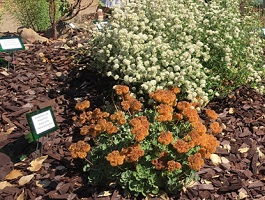 Now near this island is an open area between heritage coast live oak trees, Quercus agrifolia. Our vision was to have a network of islands/berms in this open area. Neighbors wanted to have an alternative to weeds and summer dust storms. The area is about 120 foot by 120 foot. We envisioned five CA native plant islands in this open area.
Now near this island is an open area between heritage coast live oak trees, Quercus agrifolia. Our vision was to have a network of islands/berms in this open area. Neighbors wanted to have an alternative to weeds and summer dust storms. The area is about 120 foot by 120 foot. We envisioned five CA native plant islands in this open area.
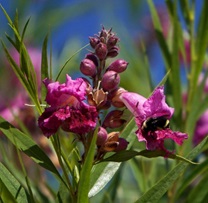 Part of the reason for the passage of time was due to the drought. The City policy became ‘no new plantings’. Then, a couple of years ago, with MFPA postured financially to support a major project, the idea came to the fore and I was asked to implement the proposed project. During the four years leading up to this okay, we had been in multiple conversations with our Parks Department in San Jose about the Five Island Project. About a year ago, we broke ground.
Part of the reason for the passage of time was due to the drought. The City policy became ‘no new plantings’. Then, a couple of years ago, with MFPA postured financially to support a major project, the idea came to the fore and I was asked to implement the proposed project. During the four years leading up to this okay, we had been in multiple conversations with our Parks Department in San Jose about the Five Island Project. About a year ago, we broke ground.
The elongated islands are about 35 by 15 foot and of elliptical shape. The spine is about 2 foot high, tapered to ground level, providing good drainage. The native soil was removed or ‘dished’; and this native dirt (sand and adobe) was mixed with ‘garden soil’ from Evergreen Supply in San Jose. It is the lowest grade of organic soil on the market. The combined soils were used to create the islands/berms. Each island is sponsored, to raise money to implement the project. We have five sponsors: East Bay Wilds, DGDG, Almaden Valley Nursery, PG&E and the past presidents of our organization: MFPA (Martin-Fontana Parks Association):
https://martinfontanaparksassociation.blog

After forming the islands, plants were planted. Each sponsor selected plants and designed their own gardens. Directly after planting, drip-irrigation was installed. We are using Techline drip line with pressure-opened emitters: 1 gallon per hour per emitter. The emitters are spaced 18 inches apart. I designed the irrigation system and will relate at the site-visit. Currently, due to low rain (nothing Jan and Feb), we irrigate every 8 days for 1/2 hour and this is working out fine. We have a variety of water-need plants on the island, by design, so it will be a challenge to fine-tune any summer watering. The islands were planted from mid-Jan through the end of February, which worked out great as you recall the beautiful weather (minus rain). The plants seem very happy with their new homes.
Additional information is available at:
https://martinfontanaparksassociation.blog/2018/06/19/have-you-been-to-the-islands-yet/
Here is a plant list for the five islands.
Directions: The original two berms and the Five Islands area of the park is across from 1278 Oakglen Way, San Jose. Street parking is available.
Capitancillos Drive Native Plant Demonstration Garden
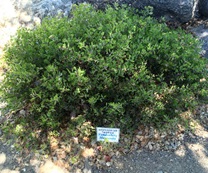 This garden adjoins over a half mile of Capitancillos Drive in San Jose. It is a labor of love by one of the residents of the neighborhood, supported by other neighbors who live along the way. Started in 1995 with the planting of 125 coast live oaks by Our City Forest (http://www.ourcityforest.org/), it has been maintained and filled in with an extensive collection of chaparral shrubs and plants. It blends beautifully with the Guadalupe Creek riparian zone, which is adjacent to the garden.
This garden adjoins over a half mile of Capitancillos Drive in San Jose. It is a labor of love by one of the residents of the neighborhood, supported by other neighbors who live along the way. Started in 1995 with the planting of 125 coast live oaks by Our City Forest (http://www.ourcityforest.org/), it has been maintained and filled in with an extensive collection of chaparral shrubs and plants. It blends beautifully with the Guadalupe Creek riparian zone, which is adjacent to the garden.
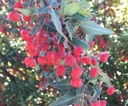 Backed by huge granite boulders and the meadow beyond, the shrubs and trees stand out nicely, yet seem to be part of the natural landscape. The plants are hand-watered until established, by Patrick Pizzo, who designed and installed this impressive garden. Lovely established specimens include a variety of ceanothus and manzanitas, sugar bush, spicebush, bush anenome, mountain mahogany, island bush snapdragon, coast silktassel, lemonade berry, sages, coyote brush, coyote mint, buckwheats, monkeyflowers, silver bush lupine, and much more. Plants are labelled, making it easy to find and identify specific cultivars.
Backed by huge granite boulders and the meadow beyond, the shrubs and trees stand out nicely, yet seem to be part of the natural landscape. The plants are hand-watered until established, by Patrick Pizzo, who designed and installed this impressive garden. Lovely established specimens include a variety of ceanothus and manzanitas, sugar bush, spicebush, bush anenome, mountain mahogany, island bush snapdragon, coast silktassel, lemonade berry, sages, coyote brush, coyote mint, buckwheats, monkeyflowers, silver bush lupine, and much more. Plants are labelled, making it easy to find and identify specific cultivars.
The garden provides food and shelter for wildlife from the adjacent Guadalupe Watershed and Guadalupe Creek. Bluebird nest boxes maintained by the Audubon Society provide additional habitat in the garden.
Here is a plant list for the garden.
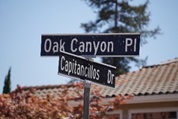
Directions: From Hwy 85, go south on Camden to Coleman. Turn left on Coleman, and left again on Redmond, then right on Oak Canyon Drive. Oak Canyon Drive becomes Oak Canyon Place. Continue to the cul-de-sac and turn about. The garden borders the meadow for 0.6 miles. Ample free parking is available on the street next to the garden.
California Native Plants at West Valley College
California native plants dominate the grounds at the West Valley College campus in Saratoga. It’s an excellent place to appreciate a wide variety of mature plants in a garden setting. Starting from the front of the campus, between the Administration building and Campus Center, one immediately encounters a huge bed of California fuschias fuschias (Epilobium canum) interspersed with narrow-leaf milkweed (Asclepias fascicularis), salvia, coffeeberry (Rhamnus californica), California roses (Rosa californica), and blue oaks (Quercus douglasii). When the fuschias begin blooming in late summer, this area becomes a hummingbird haven, filled with a charm of these tiny birds zooming around each defending their own patch of flowers.
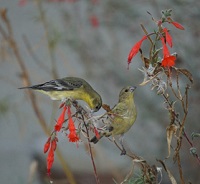 This huge bed of flowers is a wildlife magnet – in addition to hummingbirds, the area is rich with a variety of birds taking advantage of the nectar, seeds and insects. As can be seen in this picture, the flower stalks provide a perfect perch for a pair of lesser goldfinches to enjoy a meal of fuschia seeds.
This huge bed of flowers is a wildlife magnet – in addition to hummingbirds, the area is rich with a variety of birds taking advantage of the nectar, seeds and insects. As can be seen in this picture, the flower stalks provide a perfect perch for a pair of lesser goldfinches to enjoy a meal of fuschia seeds.
Behind the Student Center, there is a patio where Redbud and manzanitas have been planted. A variety of native columbines and other flowers can be found in the flowerbeds that surround the building.
The section of Vasona Creek that runs through the campus has also been restored, and is a delightful place to look for wildlife – including brush rabbits, lizards and more. There have even been reports of bobcats in the area. You c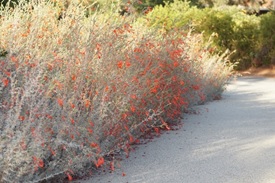 an find out more about this restoration project at: http://westvalley.edu/committees/Sustainability/Creek_Restoration/
an find out more about this restoration project at: http://westvalley.edu/committees/Sustainability/Creek_Restoration/
A stroll through campus will reveal even more California natives. You’ll find specimens of blue elderberry (Sambucus nigra ssp. caerulea), redwood trees (Sequoia sempervirens), deer grass (Muhlenbergia rigens), bush anemone (Carpenteria alifornica), buckeyes (Aesculus californica) and more. There’s even a small bog with carnivorous plants next to the Science building. Be sure to look at the huge blue oak tree in the center of campus – watch it carefully and you are likely to spot the acorn woodpeckers that are often busily at work in it.
The Saratoga Farmer’s Market is held at the campus on Saturday mornings – stop by and get some fresh produce and then take a stroll around campus.

 Many nurseries and even big box hardware stores carry a limited number of native plant seeds and seed mixes, but it can be challenging trying to find packets of seed mixes with only natives as many mixes that include "California" in the name include non-native seeds. It's important to carefully read the list of included flowers before buying. We've identified two native seed mixes that have been spotted in Bay Area stores:
Many nurseries and even big box hardware stores carry a limited number of native plant seeds and seed mixes, but it can be challenging trying to find packets of seed mixes with only natives as many mixes that include "California" in the name include non-native seeds. It's important to carefully read the list of included flowers before buying. We've identified two native seed mixes that have been spotted in Bay Area stores:
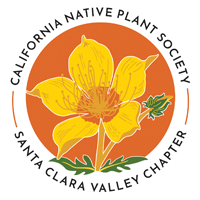



 Ready to get started? Here are some simple steps to transform your garden into a welcoming place for birds, butterflies, bees and other wildlife:
Ready to get started? Here are some simple steps to transform your garden into a welcoming place for birds, butterflies, bees and other wildlife:
 Want to do more?
Want to do more?  A beautiful selection of mature and new native plant gardens can be found in Jeffry Fontana Park in San Jose. Wandering through the park, you will find plants from both northern and southern California in a variety of settings.
A beautiful selection of mature and new native plant gardens can be found in Jeffry Fontana Park in San Jose. Wandering through the park, you will find plants from both northern and southern California in a variety of settings. This is the perfect place to view plants that grow well in San Jose and find ideas for your own gardens.
This is the perfect place to view plants that grow well in San Jose and find ideas for your own gardens.
 Now near this island is an open area between heritage coast live oak trees, Quercus agrifolia. Our vision was to have a network of islands/berms in this open area. Neighbors wanted to have an alternative to weeds and summer dust storms. The area is about 120 foot by 120 foot. We envisioned five CA native plant islands in this open area.
Now near this island is an open area between heritage coast live oak trees, Quercus agrifolia. Our vision was to have a network of islands/berms in this open area. Neighbors wanted to have an alternative to weeds and summer dust storms. The area is about 120 foot by 120 foot. We envisioned five CA native plant islands in this open area.  Part of the reason for the passage of time was due to the drought. The City policy became ‘no new plantings’. Then, a couple of years ago, with MFPA postured financially to support a major project, the idea came to the fore and I was asked to implement the proposed project. During the four years leading up to this okay, we had been in multiple conversations with our Parks Department in San Jose about the Five Island Project. About a year ago, we broke ground.
Part of the reason for the passage of time was due to the drought. The City policy became ‘no new plantings’. Then, a couple of years ago, with MFPA postured financially to support a major project, the idea came to the fore and I was asked to implement the proposed project. During the four years leading up to this okay, we had been in multiple conversations with our Parks Department in San Jose about the Five Island Project. About a year ago, we broke ground. 
 This garden adjoins over a half mile of Capitancillos Drive in San Jose. It is a labor of love by one of the residents of the neighborhood, supported by other neighbors who live along the way. Started in 1995 with the planting of 125 coast live oaks by Our City Forest (
This garden adjoins over a half mile of Capitancillos Drive in San Jose. It is a labor of love by one of the residents of the neighborhood, supported by other neighbors who live along the way. Started in 1995 with the planting of 125 coast live oaks by Our City Forest ( Backed by huge granite boulders and the meadow beyond, the shrubs and trees stand out nicely, yet seem to be part of the natural landscape. The plants are hand-watered until established, by Patrick Pizzo, who designed and installed this impressive garden. Lovely established specimens include a variety of ceanothus and manzanitas, sugar bush, spicebush, bush anenome, mountain mahogany, island bush snapdragon, coast silktassel, lemonade berry, sages, coyote brush, coyote mint, buckwheats, monkeyflowers, silver bush lupine, and much more. Plants are labelled, making it easy to find and identify specific cultivars.
Backed by huge granite boulders and the meadow beyond, the shrubs and trees stand out nicely, yet seem to be part of the natural landscape. The plants are hand-watered until established, by Patrick Pizzo, who designed and installed this impressive garden. Lovely established specimens include a variety of ceanothus and manzanitas, sugar bush, spicebush, bush anenome, mountain mahogany, island bush snapdragon, coast silktassel, lemonade berry, sages, coyote brush, coyote mint, buckwheats, monkeyflowers, silver bush lupine, and much more. Plants are labelled, making it easy to find and identify specific cultivars.
 This huge bed of flowers is a wildlife magnet – in addition to hummingbirds, the area is rich with a variety of birds taking advantage of the nectar, seeds and insects. As can be seen in this picture, the flower stalks provide a perfect perch for a pair of lesser goldfinches to enjoy a meal of fuschia seeds.
This huge bed of flowers is a wildlife magnet – in addition to hummingbirds, the area is rich with a variety of birds taking advantage of the nectar, seeds and insects. As can be seen in this picture, the flower stalks provide a perfect perch for a pair of lesser goldfinches to enjoy a meal of fuschia seeds. an find out more about this restoration project at:
an find out more about this restoration project at: 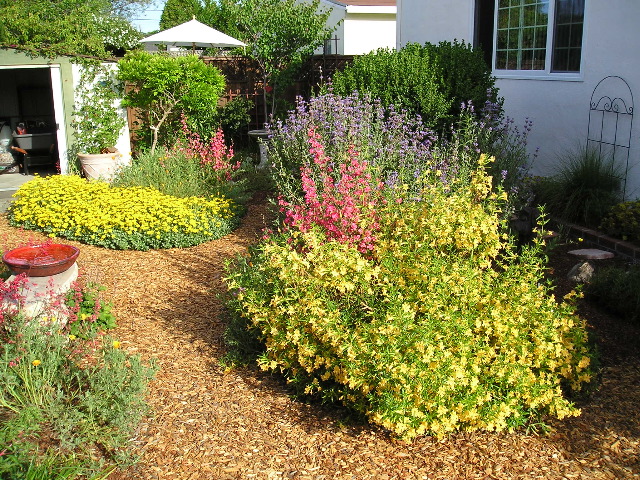 Do you want a garden teeming with life? One that changes with the seasons? One that looks stunning? One that saves water, energy, effort, and money? Consider incorporating California native plants in your garden to attract butterflies, birds, and other wildlife. These beautiful plants will bring seasonal color to your landscape. They will give your California garden a unique sense of place.
Do you want a garden teeming with life? One that changes with the seasons? One that looks stunning? One that saves water, energy, effort, and money? Consider incorporating California native plants in your garden to attract butterflies, birds, and other wildlife. These beautiful plants will bring seasonal color to your landscape. They will give your California garden a unique sense of place.